Choosing the Perfect Outdoor Rugs: Key Considerations
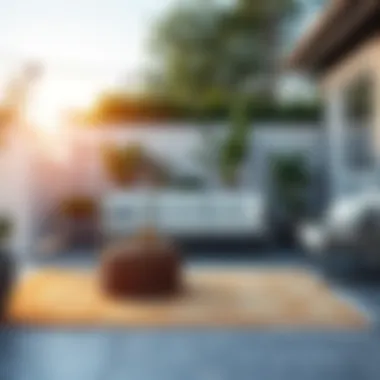
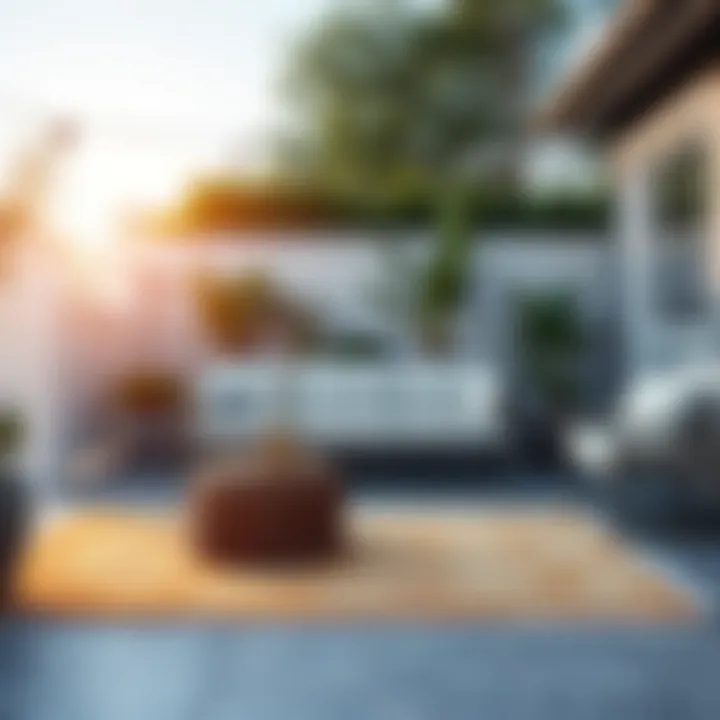
Intro
When it comes to enhancing your outdoor space, the choice of rug can significantly elevate the environment. Not only do outdoor rugs add visual appeal, but they also contribute to comfort and functionality. As homeowners, interior design enthusiasts, and party hosts seek ways to merge aesthetics with practicality, understanding the key elements of outdoor rugs becomes vital.
Selecting the right rug isn't just about picking a pretty pattern. Materials, styles, and maintenance play crucial roles in ensuring that the rug can withstand the elements while still looking fabulous. With this comprehensive guide, we aim to arm you with the knowledge you need for making informed decisions that breathe life into your exteriors.
Design Inspirations
Trending Styles
In the realm of outdoor rugs, styles are as diverse as the landscapes they adorn. Some popular trends include:
- Natural Weave: These rugs, often made from jute or seagrass, bring an organic texture that feels at home in any garden setting, blending seamlessly with nature.
- Geometric Patterns: For those looking to make a statement, bold, geometric designs add a modern flair, perfect for contemporary patios or balconies.
- Vintage Aesthetic: Rugs that mimic traditional Persian or Oriental designs can create a sense of timelessness, giving your outdoor space a cozy, inviting feel.
Each style has its own charm, and your choice will largely depend on your existing décor and personal taste.
Color Palettes
Colors can transform the atmosphere of any area. When choosing an outdoor rug, consider:
- Earth Tones: Shades of brown, beige, and green tie back to the natural environment and pair well with plants.
- Bold Accents: Bright colors like teal or yellow can serve as eye-catching focal points that energize your space.
- Monochrome Themes: For a more sophisticated look, varying shades of one color can create a cohesive and elegant vibe.
Choosing the right color could either enhance the outdoor space or leave it feeling disjointed, so think about what complements your furniture and surroundings.
"The right outdoor rug does more than just decorate; it brings functionality and warmth to your outdoor living area."
Maintenance and Upkeep
Seasonal Maintenance Checklist
Keeping your outdoor rug in pristine condition requires regular care. Here's a checklist to help you out:
- Spring: Shake out dirt and debris; inspect for fading or wear after winter.
- Summer: Spot clean stains promptly; consider using a UV protector spray for sun exposure.
- Fall: Store with other outdoor furniture if temperatures drop; clean thoroughly to prevent mildew.
- Winter: If possible, bring rugs indoors or cover them to protect against snow and ice.
Cleaning and Organization Tips
Proper cleaning and organization extend the life of your outdoor rug.
- Use a Vacuum: Gently vacuum both sides to extract dirt.
- Spot Clean with Mild Soap: For stains, combine water and a mild detergent, scrub gently, and rinse thoroughly.
- Air Dry: Sun-drying is ideal, but avoid excessive direct sunlight that might cause fading.
By following these maintenance tips, you can assure your outdoor rug remains a key element of your outdoor aesthetic for years to come.
Understanding Outdoor Rugs
Outdoor rugs have become a staple for enhancing spaces where nature meets design. They serve multiple purposes that help elevate both the comfort level and the visual appeal of outside areas. Knowing the ins and outs of these rugs equips homeowners, interior design enthusiasts, and gardening aficionados with the necessary tools to make informed decisions. This guide unfolds the significance of outdoor rugs, their unique benefits, and the role they play in protecting surfaces.
Definition and Purpose
Outdoor rugs, as their name implies, are textiles specifically designed for external environments, tailored to withstand the elements while providing comfort underfoot. These rugs come in various materials, styles, and sizes, catering to a spectrum of aesthetic preferences and functional requirements. The primary role of these rugs is quite straightforward: they help delineate spaces, offer a warm feel, and broadly speaking, contribute to creating inviting outdoor settings. Whatever your vision—from a serene garden nook to a bustling patio—outdoor rugs can help set the tone.
Benefits of Using Outdoor Rugs
Increased Comfort
When it comes to outdoor lounging, one often overlooks the comfort factor. Having a rug underfoot transforms a cold, hard surface into a cozy haven. Whether it's the feet of wandering guests or children playing, a rug can soften the sting of hard ground. Increased Comfort allows for longer stays, meaning gatherings can go into the night without anyone feeling like they're standing on stones.
Moreover, outdoor rugs act as insulators against chilly surfaces, smoothing out heat retention during those warmer months as well. This aspect is what makes them a popular choice among outdoor enthusiasts. Yet, not all rugs are equal in this department; some may wear out quickly due to prolonged exposure to sunlight and weather. Carefully selecting rugs made with comfort and resilience in mind can be a game-changer.
Enhanced Aesthetic Appeal
Enhanced Aesthetic Appeal is yet another reason to consider adding an outdoor rug to your space. Placing a rug can create a unifying effect, tying together disparate elements of decor while injecting color and texture. Think of it as the icing on the cake, bringing harmony and visual delight.
Whether opting for bold patterns or subtle tones, outdoor rugs can elevate the overall ambience. Additionally, they can help disguise imperfections in the floors—be it patio tiles or wood decking—ensuring your space looks polished without requiring extensive alterations. The unique feature of versatility here is notable. You can easily swap out rugs based on seasons or events, maintaining freshness and style throughout the year.
Protection for Outdoor Surfaces
Protection for Outdoor Surfaces is a crucial consideration as well. Without a proper rug, outdoor surfaces can quickly suffer from wear and tear caused by furniture placement or foot traffic. A good quality outdoor rug acts as a barrier, protecting your patio or deck from scratches, stains, and fading.
This characteristic makes outdoor rugs not only decorative items but practical investments. However, one has to choose wisely; some materials might not offer the same level of durability. For example, acrylic fibers offer good protection but can also fade if left out all summer long. The balance between aesthetics and practicality must be weighed carefully, as ultimately the goal is to achieve beauty without sacrificing longevity.
In summary, outdoor rugs bring a wealth of benefits that go far beyond mere decoration—they enhance comfort, improve aesthetics, and protect underlying surfaces, making them invaluable additions to any outdoor area.
Key Materials for Outdoor Rugs
Choosing the right materials for outdoor rugs is vital since these pieces not only provide comfort and style but also need to withstand various weather conditions. This section details the types of materials available and helps you make informed decisions based on durability, maintenance, and aesthetic appeal.
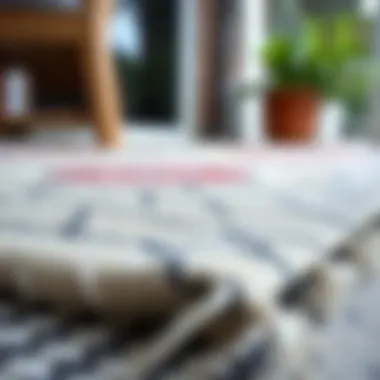
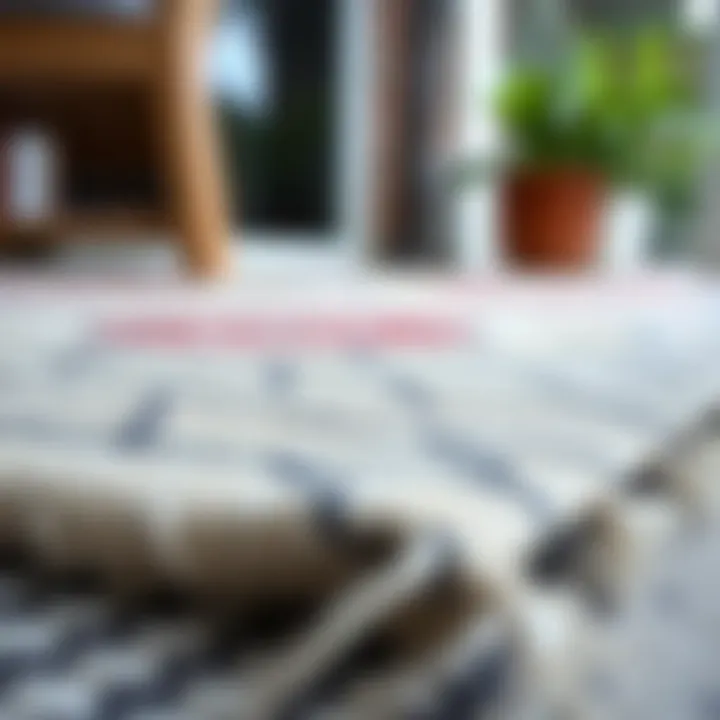
Synthetic Fibers
Synthetic fibers are a popular choice for outdoor rugs due to their resilience and low maintenance requirements. They can mimic the look of natural materials while offering enhanced durability, making them ideal for exposed environments.
Polypropylene
Polypropylene is one of the most commonly used synthetic fibers for outdoor rugs. Its strength is a standout feature, and it's resistant to stains, moisture, and mildew, which makes it a practical option. This material is lightweight, allowing for easy cleaning and movement. The availability of various colors and designs also makes polypropylene versatile for different design aesthetics.
However, a notable downside is its environmental impact, as it is derived from petroleum products. Though it lasts longer than some natural fibers, the non-biodegradable nature of polypropylene can be a concern for eco-conscious consumers. Its longevity can be beneficial, yet the choice must be woven together with considerations of sustainability.
Nylon
Nylon is another heavyweight champion in the world of outdoor rugs. Known for its resilience, sniffing out stains is unlikely with nylon. This fiber has excellent abrasion resistance and holds up well under stress, whether from foot traffic or harsh weather. Furthermore, nylon rugs can maintain their color and texture longer compared to other materials, which is a significant plus.
Nevertheless, nylon is not as UV-resistant as other synthetic options, meaning prolonged sunlight exposure may lead to fading over time. It’s essential to balance between durability and color retention when selecting nylon, as long-term aesthetics can hinge on that. A thorough maintenance routine often helps mitigate those fading woes.
Natural Fibers
Natural fibers bring warmth and organic appeal to outdoor spaces. While they may not have the same level of durability as synthetics, their aesthetic and texture can create an inviting environment.
Jute
Jute is a fantastic natural fiber option favored for its texture and capability to absorb moisture. It won’t slip and slides around like synthetic options often do. This means that a jute rug can bring a natural, earthy feel to patios and backyard spaces. In terms of character, the rustic appearance of jute can beautifully complement various home themes.
However, jute’s susceptibility to mold when exposed to heavy rainfall can be its Achilles' heel. A jute rug requires an owner that’s willing to be vigilant with upkeep, especially when it rains. If one is ready to dedicate a bit of time to maintenance, jute becomes an aesthetically pleasing choice that reflects a more natural setting.
Hemp
Hemp is an up-and-coming choice in the realm of natural fibers for outdoor rugs. It boasts similar durability to jute but comes with even more stain resistance. Hemp fibers are tough and usually more sustainable, adding to its appeal in today’s eco-aware market. This material offers unique textures and can blend seamlessly with many outdoor decors.
Yet again, the drawbacks include sensitivity to moisture and a higher price point compared to other options. It's important for buyers to consider their specific environmental conditions and budget before choosing hemp as their material of choice.
Hybrid Materials
Hybrid materials combine the best features of both synthetic and natural fibers, creating rugs that are both durable and appealing to the eye. These materials often provide enhanced performance characteristics while preserving the aesthetic value that comes with natural fibers.
For instance, certain blends can offer UV resistance while maintaining the texture one expects from a natural fiber. This can be a solution for homeowners looking to marry functionality with style, ensuring their rugs can endure the elements without sacrificing visual pleasure. Hybrid materials come in various forms and can sometimes be tailored for specific outdoor applications.
By understanding the various materials available for outdoor rugs, homeowners, interior design enthusiasts, and garden lovers can make selections that suit their personal style and withstand the wear and tear offered by outdoor living spaces.
Styles of Outdoor Rugs
Outdoor rugs are not merely functional; they play a pivotal role in shaping the overall aesthetic of your environment. They can transform an otherwise drab patio or deck into a vibrant gathering space. Selecting the right style becomes crucial, as it greatly affects how the outdoor area feels to you and your guests. Each design choice can reflect personal taste, complement existing architecture, and harmonize with nature.
Modern Designs
When it comes to modern outdoor rug designs, think contemporary aesthetics with a splash of minimalism. These rugs often feature bold colors and clean lines that blend seamlessly with sleek outdoor furniture. They can infuse a sense of sophistication into an outdoor environment. Imagine lounging on a fresh white deck, and underfoot, you have a navy blue, abstract patterned rug that not only visually enriches the space but also feels pleasant against your feet.
Modern styles often utilize synthetic fibers that resist fading and wear, making them ideal for places exposed to direct sunlight and unpredictable weather. Additionally, the choice of patterns is quite diverse, ranging from large floral prints to stark, geometric designs. Homeowners can easily choose what aligns with their existing decor while simultaneously setting a fresh tone.
Traditional Patterns
Traditional outdoor rugs often evoke a sense of nostalgia, bringing to mind intricate motifs passed down through generations. These designs can add a rich, warm feel, making outdoor gatherings more inviting. Patterns like Persian or Oriental can imbue a sense of classic elegance and grandeur, resonating well especially with vintage or rustic decor themes.
Using a rug that features these traditional patterns can make open spaces feel more intimate, creating a cozy atmosphere suitable for conversation and relaxation. It's important to choose colors that coordinate with the surrounding items, as too much contrast might disrupt the overall harmony of your outdoor setup.
Geometric Shapes and Textures
Geometric designs and varied textures stand out as a favorite among those looking to create dynamic outdoor spaces. These rugs often incorporate a mix of diamond shapes, chevrons, and triangles that can guide the eye across the space and add a playful touch. Textures, such as looped or shag piles, can add depth, inviting people to kick off their shoes and enjoy a tactile experience.
One might consider using textured rugs to soften hard surfaces like stone or wood floors. These add a layer of comfort and warmth. Moreover, geometric patterns can provide a modern flair, especially when paired with contemporary furniture. For example, a black and white chevron rug might contrast sharply with brightly colored outdoor cushions, offering a striking balance.
"Choosing the right style of outdoor rug not only reflects personal taste but also enhances the functionality of your outdoor space."
By exploring these diverse styles, homeowners can find an outdoor rug that not only meets practical needs but also elevates the ambiance of their patio, garden, or terrace. The right choice speaks volumes about the homeowner’s aesthetic preferences and provides a foundation for outdoor living that feels cohesive and intentional.
Choosing the Right Size
Selecting the appropriate size of an outdoor rug is crucial for achieving both functionality and aesthetics in your outdoor setting. A well-suited rug can define spaces, create a sense of cohesion, and add warmth to outdoor areas. When thinking about size, homeowners must consider the dimensions of the furniture, the intended purpose of the space, and the overall layout. The right rug can elevate the overall ambiance while providing comfort underfoot, especially in areas meant for gatherings or relaxation.
Standard Dimensions
When it comes to outdoor rugs, the market offers a variety of standard dimensions that cater to common settings. Here are some prevalent sizes:
- 3' x 5': Typically great for small entryways or balconies, offering just enough coverage without overwhelming the space.
- 5' x 8': A versatile option that suits smaller seating areas or as an accent under a table. It provides ample coverage for essential furniture while maintaining open space around it.
- 8' x 10': This size works wonders for larger patios, comfortably accommodating several pieces of outdoor furniture.
- 9' x 12': Ideal for expansive setups. This rug size can anchor multiple seating arrangements, creating a defined social area.
These standard sizes give a solid foundation for many homeowners, but they may not work for every unique situation.
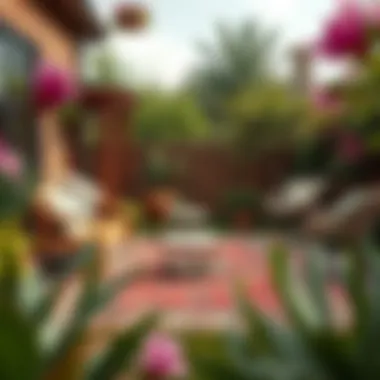
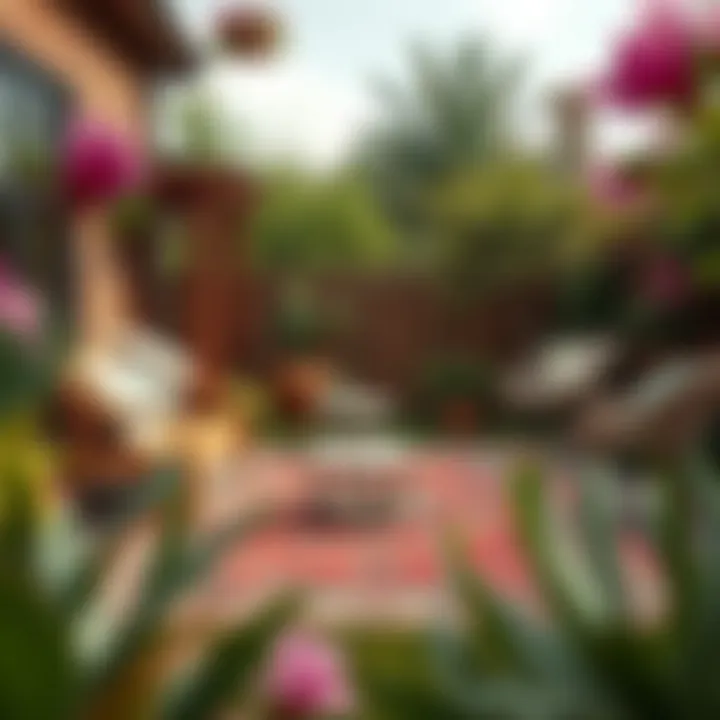
"The right size can not only enhance the appeal of your space, but it can also determine how the flow of movement works around it."
Custom Sizes and Shapes
Sometimes standard sizes just won't cut it. This is where custom sizes and shapes come into play. The benefit of tailored options is significant for homeowners looking to fit unusual spaces or create a specific design aesthetic.
- Irregular Spaces: For areas shaped oddly, like a round or L-shaped patio, a custom rug can ensure a perfect fit. This consideration removes the mismatch that often occurs with standard sizes.
- Unique Designs: Tailor-made rugs can be tailored in shapes like circular or even hexagonal designs, giving a distinctive flair to an outdoor setting. This is particularly appealing for those wanting to create a more personalized touch.
- Maximizing Utility: Homes with large, open spaces can benefit from larger, custom rugs that cover considerable ground, providing a unified look while defining designated areas for lounging, dining, or activities.
Choosing the right size—be it standard or custom—is a vital step in decorating outdoor spaces. It makes a world of difference in aesthetics and functionality, helping to create an inviting atmosphere that resonates with your style. After all, it’s all about bringing the indoors out while ensuring comfort underfoot.
Climate Considerations
When selecting outdoor rugs, it's essential to account for the climate in which they will be used. Weather conditions often dictate not just the durability of a rug but also its appearance over time. Understanding how different elements—such as sun exposure, rainfall, and temperature fluctuations—affect the materials used can help homeowners make informed choices that enhance both utility and aesthetics.
Weather Resistance
UV Stability
One major aspect of outdoor rugs is their UV Stability. This property relates to a rug's ability to resist degradation from ultraviolet rays. For homeowners aiming to maintain vibrant colors and structural integrity, UV stability is crucial. Rugs designed with high uv stability often use synthetic fibers, specifically polypropylene or nylon, which are less likely to fade in the harsh sunlight. This makes them a popular choice for areas that see a lot of direct sunlight.
The unique feature of uv stability is that it extends the life of the rug, allowing for a great внешний вид for much longer. On the downside, not all materials offer effective UV protection. Natural fibers like jute or hemp may degrade quicker, losing their appeal in sunny environments, necessitating regular replacement. Thus, selecting a rug with high UV stability translates to less hassle and cost over the long run.
Water Resistance
Water resistance stands as another critical characteristic for outdoor rugs, especially in regions prone to rain or high humidity. A water-resistant rug prevents moisture from seeping into its fibers, minimizing the risk of mold and mildew growth. This feature is particularly beneficial for homeowners who enjoy outdoor gatherings regardless of weather forecasts.
However, while many synthetic rugs offer excellent water resistance, it's important to note that heavy rain can still impact their lifespan. A unique advantage of water-resistant rugs is their ease of cleaning, as spills or dirt can usually be wiped or hosed off.
Nevertheless, choosing a rug that is solely water-resistant might not suffice in colder climates, where freezing temperatures could also be an issue. Picking a rug that balances both water and UV resistance will ensure durability and satisfaction over time.
Temperature Adaptability
Adapting to varying temperatures is also an important consideration that can significantly influence rug performance. Outdoor spaces frequently experience dramatic shifts in temperature, and rugs must be resilient enough to handle these changes.
This adaptability ensures that the outdoor rugs remain functional, remaining intact during both the sweltering heat of summer days and the brisk cold of winter nights. Rugs made from synthetic materials usually perform better in terms of temperature fluctuations. Natural fibers might struggle, possibly leading to shrinking or warping when exposed to extremes.
In summary, when it comes to selecting outdoor rugs, homeowners should pay attention to climate considerations like UV stability, water resistance, and temperature adaptability. These factors not only contribute to the longevity of the rugs but also enhance the overall outdoor experience. Educating oneself on these aspects leads to better choices, ultimately improving the aesthetics and functionality of one’s outdoor space.
"Choosing the right outdoor rug is not just about aesthetics; it’s about understanding your environment and making thoughtful selections that will stand the test of time."
Caring for Outdoor Rugs
Taking care of outdoor rugs is not just a matter of keeping them looking pretty; it’s fundamental to maintaining both their visual and structural integrity. An outdoor rug takes quite a beating—sunshine, rain, dust, and foot traffic can all wear them down if proper care isn’t taken. By delving into regular maintenance, stain removal strategies, and the right storage solutions, you position your outdoor space to shine, regardless of the weather.
Cleaning Techniques
Regular Maintenance
Regular maintenance is akin to watering a plant—the more consistently you care for it, the healthier it stays. For outdoor rugs, regular maintenance involves shaking off dirt, vacuuming, or hosing them down from time to time. This routine prevents grime from setting in and becoming a larger issue later on.
Benefits of regular upkeep include extending the lifespan of your rug and maintaining its color and texture. A key characteristic of this practice is its simplicity; most of the techniques are quick and efficient. Moreover, it's a beneficial choice as it saves you from having to resort to more intensive cleaning methods later, which can require harsh chemicals or heavy scrubbing.
However, while regular care is easy, the drawback can come from neglecting it. If you let dirt and debris accumulate over time, they can abrade the material and lead to premature wear. It’s about striking a balance—finding the right frequency that suits your lifestyle.
Stain Removal
Stain removal is an essential aspect of keeping outdoor rugs looking their best. Whether it’s spilled juice or muddy paw prints, stains can detract from the beauty of your outdoor area. Quick action is crucial when dealing with stains. Addressing them immediately prevents them from setting and becoming stubborn marks that are hard to eliminate.
A pivotal characteristic of stain removal is that it usually requires specific products or methods tailored to the type of stain. For instance, soapy water can work wonders on organic stains, whereas vinegar might help with pet-related stains. This targeted treatment approach makes stain removal a popular and effective choice in maintaining outdoor rugs.
On the flip side, there's a nuanced challenge. Not all stains are created equal, and some may require professional cleaning. If a stain is addressed poorly or ignored for too long, it can lead to permanent damage, impairing the look and feel of your rug.
Storage Solutions
When the seasons change, or the forecast predicts a heavy bout of rain, storing outdoor rugs properly becomes just as important as regular cleaning. It's sensible to consider storage solutions that will protect your rugs from extreme weather and keep them in prime condition.
The best practice involves rolling your rugs rather than folding them, as rolling eliminates creases that might damage the fabric over time. If you have space, a dry and clean storage area like a basement or a dedicated storage shed can work wonders for longevity. Additionally, placing your rugs in breathable storage bags can help keep out moisture and pests.
By taking care of your outdoor rugs, you not only prolong their life but also enhance the overall ambiance of your outdoor areas. Good upkeep leads to a space where you love to linger, and that’s the real essence of integrating these decorative yet functional elements into your home. The beauty of a well-cared-for outdoor rug lies in its ability to remain an inviting touch to your outside space, season after season.
Integrating Outdoor Rugs into Design
Integrating outdoor rugs into your design scheme is not merely a decorative choice; it plays a pivotal role in enhancing the overall experience of an outdoor space. An outdoor rug does more than just lie flat beneath your patio furniture; it helps establish a cohesive look, brings comfort underfoot, and can even impact the mood of the area. When used effectively, outdoor rugs can tie various elements together, reflecting both personal style and practicality.
Harmonizing with Outdoor Furniture
In order to achieve a harmonious outdoor setting, it's vital to consider how your chosen rug complements the existing furniture. For instance, if you have a set of sleek metal chairs paired with a modern glass table, selecting a rug with bold geometric patterns can create a striking contrast that enlivens the area. Alternatively, for a rustic wooden dining set, a jute or natural fiber rug could enhance the organic feel of the space. Achieving balance is key; ensure the rug's colors and patterns enhance rather than clash with your furniture’s design and hue.
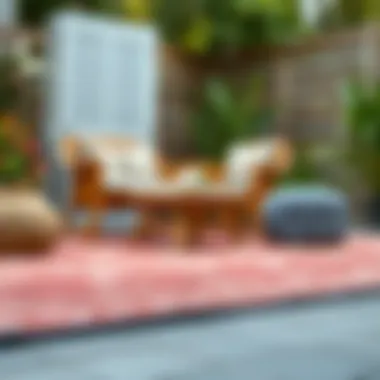
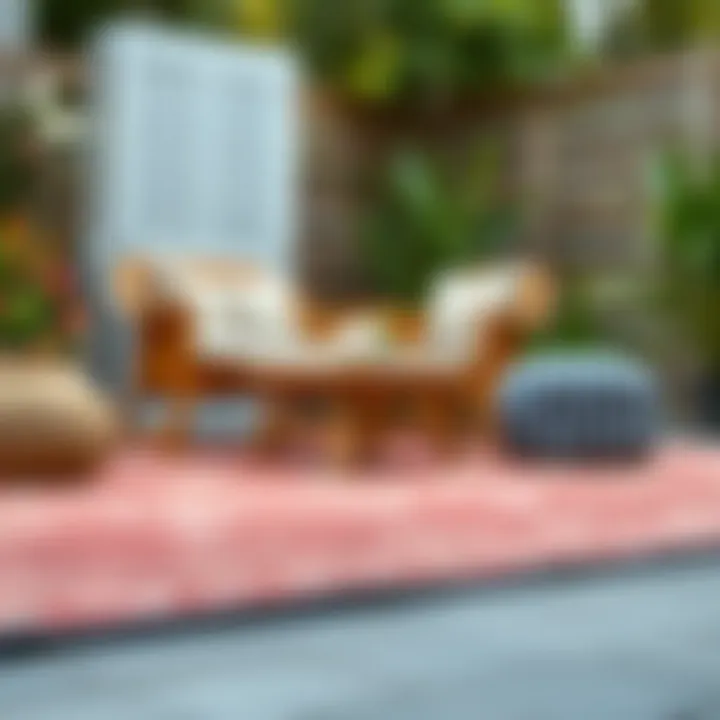
To simplify your options, consider these tips:
- Color Connection: Choose a rug color that reflects one or more shades in your furniture or decor. This ensures everything meshes well together.
- Material Match: If your outdoor furniture is more relaxed and casual, a soft, textured rug can elevate comfort without overly formalizing the space. Conversely, more refined furniture might pair well with a sleeker rug texture.
- Size Matters: Ensure the rug is appropriate for the furniture layout. Ideally, front legs of chairs should rest on the rug to anchor the area and weed out any sense of floating furniture.
Creating Outdoor Zones
Outdoor spaces can often feel vast and undefined, particularly when there are multiple areas designed for different activities. An outdoor rug can play the role of a visual anchor, helping to delineate various zones within your exterior area. By positioning rugs in specific spots, you guide guests and family members intuitively through your landscape.
For example, if your backyard features an eating area and a relaxation zone with lounge chairs, placing a rug under the dining set will clearly indicate one dining space, while a different texture or style can define the lounge area. Here’s a strategic outline to assist in creating these zones:
- Define Each Area: Use different rugs to designate specific functions, such as dining, lounging, or cooking. This organization helps in visualizing space and its uses.
- Consider Patterns and Shapes: A round rug in the seating area can promote coziness, while square or rectangular rugs under dining sets can provide structure.
- Layering Techniques: Don't hesitate to layer rugs for a bohemian look. A larger neutral rug can serve as a base, with a colorful one atop it, nailing a layered effect that adds texture and intrigue.
"A rug can make or break your outdoor experience, providing not only comfort but also a style statement that can transform an ordinary area into a personal oasis."
Investing time and effort into integrating outdoor rugs into your design scheme is well worth it. The strategic placement and thoughtful selection of these rugs will lend character and purpose to your outdoor adventures, creating spaces that invite relaxation, dining, and enjoyment. Remember, the right rug is not just about looks; it enhances functionality and creates a warm atmosphere where memories are made.
Sustainability in Outdoor Rugs
In an era where environmental responsibility takes center stage, sustainability in outdoor rugs has become crucial. As homeowners seek to enhance their outdoor spaces, the choice of materials and production processes plays an important role—not just in terms of aesthetics but also in reducing your carbon footprint. Understanding sustainability can guide you toward selections that align with ethical consumerism while maintaining high aesthetic standards.
Eco-Friendly Materials
When it comes to selecting outdoor rugs, opting for eco-friendly materials should be high on your list. These materials are often sourced and produced with minimal environmental impact, promoting sustainability. Here are some notable options to consider:
- Recycled Plastics: Rugs made from recycled plastic bottles are durable and weather-resistant. They are also easy to clean and maintain, making them ideal for outdoor settings.
- Bamboo Fibers: Bamboo grows rapidly, requires little water, and absorbs a significant amount of carbon dioxide as it matures. Rugs made from bamboo fibers add a natural touch to your outdoor decor.
- Organic Cotton: Though not typically associated with outdoor use, organic cotton rugs treat the environment with care. They are grown without synthetic pesticides, making them better for the planet.
Choosing these materials does not merely protect the environment; it also supports eco-conscious brands that prioritize sustainability. This ensures that your investment goes not only into beautifying your space but also into preserving it for generations to come.
Recycling and Reusability
Another significant aspect of sustainable outdoor rugs is recycling and reusability. Many manufacturers are taking responsibility for their products beyond the point of sale. This is a step in the right direction. Here are ways to ensure you can recycle or reuse your outdoor rugs:
- Check for Recycling Programs: Some brands have established take-back programs that allow you to send back old rugs for recycling when you’re ready to replace them. This not only keeps the rugs out of landfills but also can sometimes offer discounts on new purchases.
- Reuse in Creative Ways: Outdoor rugs can be repurposed even if they’re worn out. For instance, you can cut them into smaller mats for mudrooms, or use them as protective liners in garden beds.
- Multi-Functionality: Select rugs that can also serve as layered accents indoors in the design of your home. This will enhance your living space while keeping your investment valuable and eco-friendly.
"Sustainable choices in home decor aren’t just a trend; they reflect a growing awareness of the impact we have on the planet and the responsibility we carry for its future."
By paying attention to these elements in your purchasing decision, you contribute to a more sustainable environment and elevate your outdoor space with a conscientious touch.
Price Range and Budgeting
When it comes to selecting outdoor rugs, understanding the price range and how to budget effectively for this essential element can significantly impact your overall patio or garden space. Outdoor rugs not only serve as a practical solution for comfort and functionality but also play a crucial role in enhancing the aesthetic appeal of outdoor areas. Hence, balancing quality with cost is paramount to make an informed purchase.
Several factors contribute to the price of outdoor rugs, and having a clear grasp of these can help you navigate the landscape wisely. From material quality to size, all these elements can sway the final price tag. Knowing where to splurge and where to save can help you avoid breaking the bank while still achieving the look and feel you desire.
Analyzing Costs
Analyzing the costs of outdoor rugs involves a detailed look at various contributing factors. First and foremost, the material is a significant determinant of price. For instance, polypropylene and nylon tend to be more affordable due to their durability and ease of production. Conversely, natural fibers like jute or hemp can set you back a bit more due to their manufacturing processes and eco-friendly nature.
Here are some key elements to consider when analyzing costs:
- Material Type: Synthetic fibers tend to be cheaper than natural options. Consider your needs and preferences.
- Size of the Rug: Larger rugs will naturally cost more than smaller ones. Think about where you want to place the rug and any specific dimensions you might need.
- Design Complexity: Intricately designed or custom rugs often cost more. If you have a unique design in mind, be prepared for a higher price tag.
- Branding: Well-known brands might charge a premium due to their reputation. Don’t overlook lesser-known brands that offer similar quality.
In this regard, it’s essential to jot down what you really want and what you can compromise on.
Value vs. Cost
When it comes to outdoor rugs, distinguishing between value and cost can be crucial. Price isn’t necessarily a reflection of quality or longevity; hence it’s essential to consider how much value a rug brings to your outdoor space.
Investing in a higher-quality rug may require a bigger initial expenditure, but the longevity and aesthetic benefits might outweigh that initial cost. Ask yourself:
- How frequently will the rug be used? If it’s for an active space where foot traffic is high, investing in a durable rug is wise.
- What is the climate like in my area? Heat or moisture can degrade cheaper materials faster.
- What are my long-term goals for the space? If you plan to host gatherings often, a good-quality, stylish rug can elevate the overall ambiance and appeal.
"The best compromise between cost and value often comes from understanding that you don’t always have to pay the highest price to get quality—sometimes it’s hidden in plain sight."
By weighing these considerations, you'll be equipped to make a choice that not only enhances your outdoor environment but also aligns with your financial capacity.
End and Final Thoughts
As we wrap up this comprehensive guide, it's essential to recognize that selecting the right outdoor rug transcends mere aesthetics. It's about creating a space that harmonizes with your lifestyle, complements your home, and withstands the weather while maintaining its charm. The interplay between materials, styles, care requirements, and environmental considerations should inform your decision-making process, ensuring your choice serves both form and function.
Recap of Key Considerations
- Material Choices: Pay attention to the nuances of different fibers, whether you lean towards synthetic options like polypropylene for durability or prefer natural materials such as jute for their organic aesthetic. Each has unique characteristics that cater to specific climate concerns and usage scenarios.
- Design and Style: Consider how the rug fits within your broader outdoor decor. From modern to traditional designs, the right style will serve as a visual anchor, bringing cohesion to your seating and dining areas.
- Size Matters: Don't cut corners. Measure your space accurately and consider how you want the rug to delineate areas.
- Care Options: Regular maintenance can't be overlooked. Understand how to clean and care for your chosen rugs to preserve their lifespan and appearance in the long run.
- Sustainability: Think about the ethical implications. Selecting eco-friendly materials boosts your design's integrity, aligning it with a commitment to sustainability by opting for recycled fibers or sustainably sourced materials.
Encouragement for Thoughtful Selection
Every homeowner, interior design enthusiast, and garden lover deserves a space that reflects their personality while being practical. When you're in the market for an outdoor rug, approach the selection with intention and thoughtfulness. Envision how many gatherings, sunny afternoons, or tranquil evenings the rug will witness. Will it provide comfort underfoot when hosting friends? Will it endure the elements while adding a touch of elegance? These considerations can significantly enhance your outdoor experience.
Ultimately, an outdoor rug isn't just a decorative item; it’s an investment into your leisure space. By integrating these insights, you can choose a rug that will not only be the finishing touch to your outdoor area but will also stand the test of time, enriching your environment daily.
"Choose wisely, and your outdoor rug will tell a story of warmth and style for years to come."
By melding functionality with aesthetic appeal, you can transform your outdoor spaces into delightful retreats. Take your time to choose wisely because, in the end, it's these thoughtful choices that elevate everyday life into something special.







